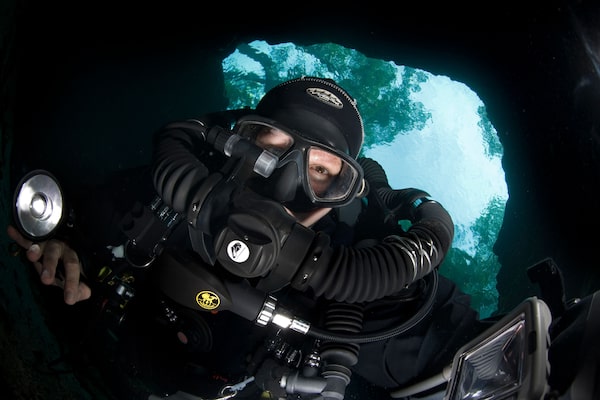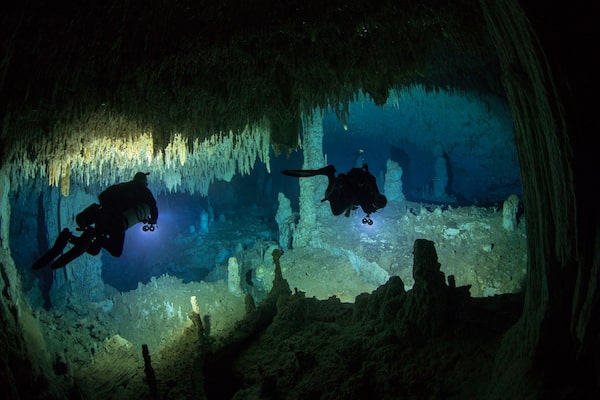
Jill Heinerth takes a selfie during a dive in Florida. Exploring underwater caves, which she calls 'the veins of Mother Earth,' is a passion for the Canadian diver, who is the Royal Canadian Geographic Society's first explorer-in-residence.Photography by Jill Heinerth
Jill Heinerth is a Canadian cave diver, underwater explorer, writer, photographer and filmmaker. She is the inaugural Explorer-in-Residence for The Royal Canadian Geographic Society, the recipient of Canada’s Polar Medal and the diving world’s highest award from the Academy of Underwater Arts and Sciences. Her new book is Into the Planet: My Life as a Cave Diver.
As a child, I wanted to be an astronaut. I imagined myself defying gravity as I effortlessly hovered in space. I would drift between the stars and the moon in my space suit and bubbled helmet, alone in the freedom of discovery. But as a young girl, that dream seemed impossible. There was no Canadian space program or female astronauts. So instead of floating through outer space, I chose to dive into the planet.
Today, I swim through the dark doorways of underwater caves, into the veins of Mother Earth. These places of beauty and wonder are like museums of natural history, carrying information about climate change, evidence of past civilizations and the remains of long-extinct animals. I realize that my dark workplace terrifies most people. I swim alone through the enclosed blackness of water-filled caves, where an error on the job may cost me my life. This highly technical pursuit has claimed the lives of dozens of my friends. Lost in the blackness, short on breathing gas, they perished, unable to escape from the confined space. But for me, the opportunity to collaborate with scientists and engineers is worth the risk. Our discoveries and maps of inner space lead to a better understanding of Earth’s past and the future of our species. Cave diving has also taught me valuable lessons about how to survive and thrive in life.
When I peer into the blackness of an underwater cave – a place that would feel claustrophobic to most people – I see opportunity. I’m not fearless. Instead of retreating, I choose to use that tingling sensation of fear to stimulate discovery. I want to know what is around the next corner. A healthy fear keeps me safe by guiding my risk assessment and choices. I like to work with colleagues who are equally afraid. It means that we both care about the outcome of our decisions. We all have figurative caves in our life. Stepping into the darkness helps everyone become an explorer, and that mindset leads to fantastic discoveries.
An underwater emergency can sometimes seem too big to manage. If I am trapped in a complete whiteout of silt and have lost contact with the safety guideline (a nylon line run through the cave for navigation), it is easy to panic. In the face of great danger, my heartbeat and breathing can speed out of control. The chattering voices in my head try to hijack my common sense. It is far better for me to turn off that primal instinct of fight or flight by taking slow, deep breaths. In controlling my heart, lungs and otherwise crippling emotions, I can focus on the next correct decision. By staying pragmatic, I can calmly choose the next decisive step toward success. That focus helps me find the lost guideline and the way out of the cave to safety.
I have learned that anything that appears impossible can be broken down into manageable steps and solutions. By courageously facing the darkness of the caves in our lives, everyone can learn that nothing is impossible.
In pictures: The view from below

Over the decades, Ms. Heinerth has dived into some of the world's least known and most inhospitable environments. For the documentary Ice Island in the early 2000s, she became the first person to dive inside an Antarctic iceberg.

In 2011, Jill Heinerth was part of a team exploring Bermuda's deep caves during a National Oceanic and Atmospheric Association project. They were the deepest manned dives in Bermuda's history.

Here, a dive team from National Geographic explores a cave beneath Abaco Island in the Bahamas. Three years after this photo was taken in 2016, Abaco was the Bahamian island most devastated by Hurricane Dorian.

John Olivero swims through a flooded mine tunnel on Newfoundland's Bell Island in 2016, more than 50 years after the last miner left it. The mine's owners abandoned the iron-ore project over a Christmas break in the 1960s, turning off the pumps that kept it from flooding. The Bell Island Mine Quest expedition wanted to see if the mine could be made into a safe diving destination and leave mainlines for future adventurers to use.

Bell Island's shores are home to shipwrecks, the result of German U-boat attacks in 1942. Ms. Heinerth led several expeditions to document the sunken Second World War history, including the one pictured here in June, 2016.

For Ms. Heinerth, who took this photo on a 2016 iceberg dive in Newfoundland, diving was the next best thing to the gravity-defying freedom of an astronaut, which she aspired to be as a child but didn't think was possible. 'By courageously facing the darkness of the caves in our lives, everyone can learn that nothing is impossible,' she says.